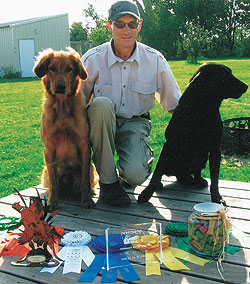"When our own litters are about five weeks old," Ken said, "we introduce them to a fresh-killed pigeon as a group. The enthusiasm of the bolder pups encourages the more timid ones to get into the game."
By James B. Spencer
 Ken Reed |
"When our own litters are about five weeks old," Ken said, "we introduce them to a fresh-killed pigeon as a group. The enthusiasm of the bolder pups encourages the more timid ones to get into the game."
In doing this, Ken ties a cord onto the bird, so he can control it. Then he tosses it into the midst of the litter of pups and twitches it around to excite them. If they get too rough with it, he picks it up quickly with the cord. If some of the puppies are getting crowded out, he lifts the bird up and drops it near them. After a few sessions, the entire litter is very birdy. Incidentally, he has someone shooting a blank pistol at an appropriate distance during these sessions.
"This isn't the litter's first exposure to gunfire," he said, "because we shoot around the whelping shed from the time they're born."
If you have bought a pup from a breeder who doesn't introduce his litters to birds, Ken recommends starting basically the same way, that is, with a bird on a cord, but he stressed that you should wait until your pup is comfortable in his new home and bonded with you.
"If the pup shows little interest in the pigeon on a cord," he said, "don't fret, and above all, don't scold the puppy! You can't force him to be birdy. If you make it all play and give him enough chances, he'll come around. On the other hand, if he starts chewing on the bird, discontinue this game and go back to dummies."
Ken starts a puppy retrieving in a narrow passageway, using a small paint roller. He teases the puppy with it, then tosses it a few feet. The puppy races after it, picks it up, and then has nowhere to go but back to Ken.
| Introducing Puppies To Birds | 

Don't miss tips for introducing your pointer here. and your spaniel here.
|
|
"To encourage a reliable return and nice delivery," Ken said, "don't take the roller from the puppy as soon as he gets to you. Instead, let him hold it while you pet and praise him awhile. Then, still praising him, gently twist it out of his mouth."
After the pup is retrieving the roller properly, Ken starts tossing a dead bird, but still in the narrow passageway. He keeps the sessions short and the retrieves few.
Next Ken introduces the puppy to a live, clip-wing pigeon that can't fly but can flop around and run. For control, he ties a cord on the pigeon's leg. That way, he can keep the more aggressive pups from damaging the bird as well as tease the more timid pups into going after it.
"As soon as a pup is comfortable with birds and delivering to hand," Ken said, "I put him on the truck with the big dogs and give him birds in the field every day. Of course, I keep the pup's marks short and simple."
He follows the same procedure--dead birds then clip-wings--when introducing a youngster to other species of birds: small ducks, large ducks, pheasants, and even geese.
As a final thought, Ken said, "The most common mistake beginners make is not giving their dogs birds early enough and often enough. I sometimes get a six-month old retriever in for training that has never had a bird. I have to spend time introducing him to birds before I can start really training him.
"In extreme cases, I might even have to force him on birds to some extent. Pity! It would've been much better to arouse his birdiness when he was a puppy."






